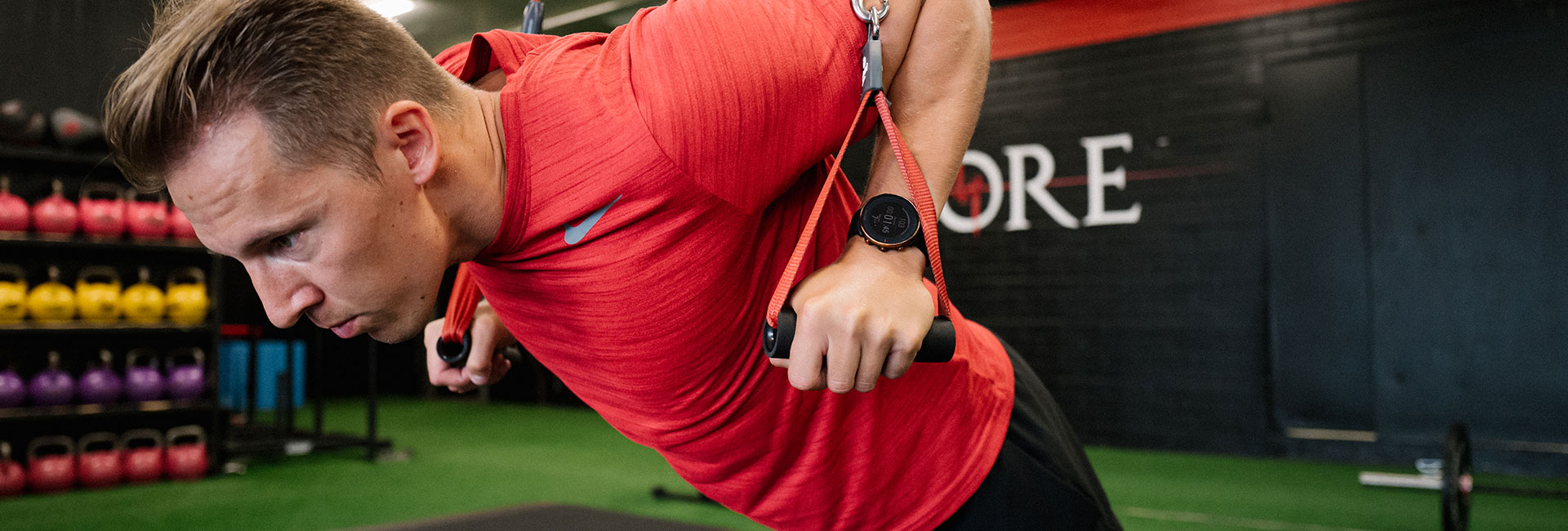When it’s too cold to run (or you just need a break from running), there are plenty of cross-training activities for runners that can help you stay in shape and even improve your running fitness during the off-season.
While winter running is possible in most conditions with the right gear, there will be days when you can’t or just don’t feel like getting out on the road for another day of training. But that doesn’t mean you should do nothing at all
By cross-training a few days per week, you can build aerobic fitness and work on your weak spots all while taking a physical and mental break from the less than ideal conditions outdoors.
We recently got together with USATF coach and founder of Strength Running Jason Fitzgerald to discuss what cross-training activities he recommends and what runners need to be mindful of when cross-training during the off-season.
Cross-Train During The Off-Season
Running isn’t the only way you can improve your endurance. Heading to the gym for a day in the pool, an indoor cycling class, or even a session on the versa climber are all ways you can get in a good cardio session when you aren’t able to get outside and run.
However, improving your cardio isn’t the only goal you should set for yourself when cross-training during the off-season. Working on your muscular weaknesses to prevent injury and improving the efficiency of your stride are two other aspects of your fitness that Fitzgerald recommends concentrating on when you aren’t on the road.
“Besides sprinting and high mileage, one of the most effective ways of improving a runner’s technique is through weightlifting,” Fitzgerald says. “Lifting relatively heavy weights is coordination training under resistance, and the skills of athleticism, coordination, and strength transfer very well to the running stride.”
While the efficiency of your stride will definitely improve by getting stronger, it’s important to note that you should have an idea of where to focus your energy.
- If you have weakness in your gluteus medius and your core, for instance, then you should spend some of your time concentrating on these areas in addition to compound strength-training movements like squats or deadlifts.
- Likewise, if you’ve battled hamstring injuries during the season, spending some time concentrating on hamstring strength and flexibility will be necessary.
This will essentially kill two birds with one stone, improving your stride while also correcting weaknesses that commonly lead to injury because of poor running mechanics.
Off-Season Training Tips For RUnners
Because you’ll be partaking in activities that you may not have a lot of experience with, there are a few things you should be aware of when cross-training during the off-season. Intensity and safety are two areas Fitzgerald recommends paying attention to when beginning any new activity.
Because of this, it’s advisable to always begin any new activity at a lower intensity than you might be used to.
“Cross-training can lead to injuries if it’s done improperly. Poor weightlifting form, taking a spill while road cycling, or even training at very high intensity level that leads to overtraining are common problems,” Fitzgerald says.
“Cross-training is used to supplement running, so choose a safe form of exercise and do it at a relatively easy or moderate intensity level. As long as the intensity (during cross-training sessions) is kept lower, runners can experiment with longer mileage during the off-season when they begin to build their base.”
For runners using off-season cross-training to supplement running in the base-building phase, this is an important point to remember. If you complete a high-intensity spin class or hit the weights hard in the gym, you’ll need a few days to recover before you complete an interval session or that scheduled long run to avoid over-extending yourself, which can also lead to injury.
The Best Off-Season Training Activities
While you can certainly play a friendly game of basketball or racquetball on a really cold day to get in a decent workout without jumping on a treadmill, there are some cross-training activities that Fitzgerald recommends for runners that are better than others.
“Cross-training for runners should mimic running so that the runner gets a physical stimulus that’s very similar to running itself,” Fitzgerald says. “If you choose forms of exercise that build aerobic fitness in a similar way as running without the impact, you’ll lower your risk of injury.”
Below are a few of the activities Fitzgerald recommends for athletes he trains during the off-season to build aerobic fitness that are easy to incorporate into your base phase of training.
Cycling
Depending on the weather, this can be done indoors or outdoors. Indoor cycling on a stationary trainer or heading to an indoor cycling class is also an excellent option if you’re looking to get in a hard interval session in a short amount of time.
Pool running
Because it simulates the running motion so closely without the stress on the lower extremities, pool running is an excellent cross-training activity in both the off-season and during the season when you may be worried about overtraining. Try an aqua jogger for a workout that will be much more difficult than you might think.
Elliptical
While most people will either love or hate this machine, it can be useful for cross-training. Give it a try when you need to warm up and cool down prior to a weight-training session.
Cross-country skiing
When it’s snowing, running might not sound like a good idea. But what about skiing? Cross-country skiing is one of the best cardiovascular activities you can partake in, and will still allow you to get outdoors and enjoy the fresh air. If skiing isn’t your thing, consider a pair of snowshoes and head out for a hike instead.
If you liked this post, don’t forget to share so that others can find it, too.
Or give it a thumbs up!
I like this article
Please note that the information provided in the Polar Blog articles cannot replace individual advice from health professionals. Please consult your physician before starting a new fitness program.





